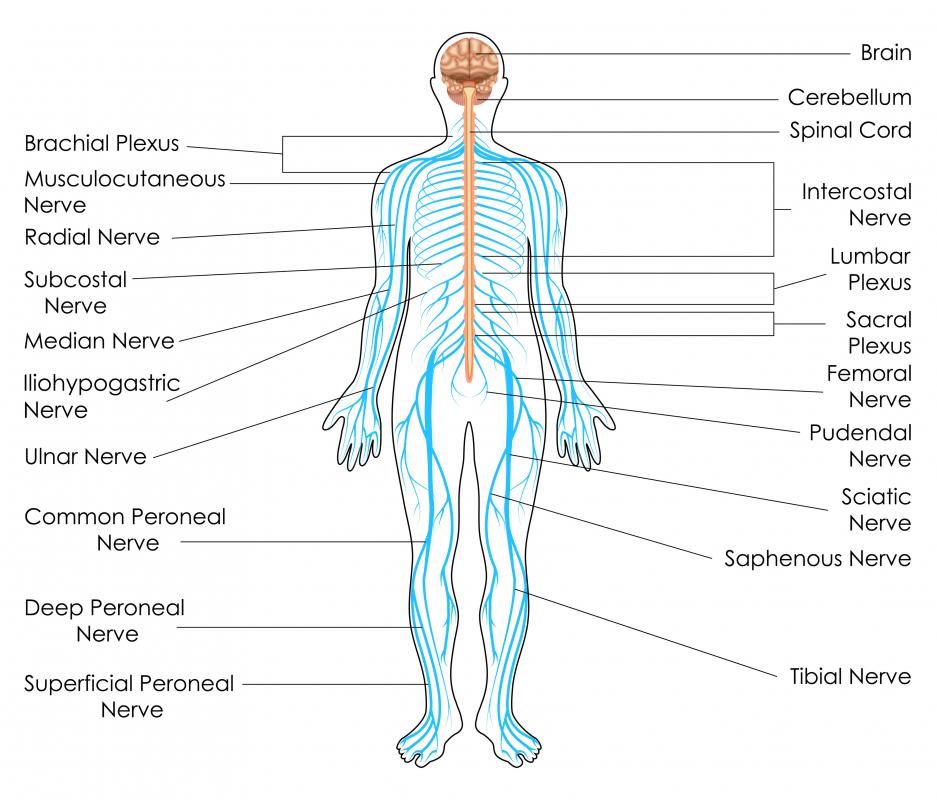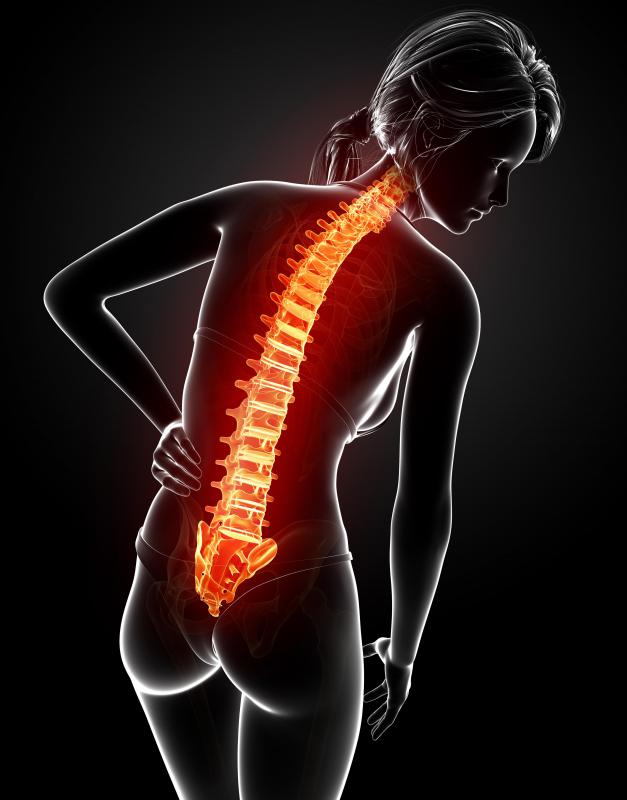At WiseGEEK, we're committed to delivering accurate, trustworthy information. Our expert-authored content is rigorously fact-checked and sourced from credible authorities. Discover how we uphold the highest standards in providing you with reliable knowledge.
What is the Lumbar Plexus?
The lumbar plexus is a nerve plexus, an area which a group of spinal nerves intersect, which innervates muscles in the lower body. This cluster of nerves is part of the larger lumbosacral plexus, which includes the lumbar plexus, sacral plexus, and pudendal plexus. Understanding the location and function of the nerves in the lumbar plexus is important to medical practitioners in a number of fields.
This nerve plexus includes the first four lumbar nerves, which innervate muscles in the calves, knees, groin, thighs, abdomen, and lower back. Patients who develop neurological problems in these areas may be examined by a neurologist who will determine where the source of the problems is; it may be in the spine, the lumbar plexus, or along the body of the nerve. Assessment of patients after accidents, spinal surgery, and spinal injuries also usually includes a detailed series of checks which are designed to determine whether any neurological problems have emerged, including an assessment of the nerves involved in the lumbosacral plexus.

The psoas muscle houses the bundle of nerves in the lumbar plexus. The nerves can be buried quite deep, especially in heavier patients who may have deposits of fat over the psoas muscle which can make it difficult to identify and isolate. For surgery involving this area of the body, the patient may be placed on his or her stomach to allow the surgeon to access the area easily and safely.

Anesthesiologists may utilize the lumbar plexus or lumbosacral plexus as a convenient location for a nerve block. Doing blocks in this area can be tricky, but highly useful, and the ability to perform such a block is a skill which an anesthesiologist is often expected to have. Nerve blocks can be used to create regional anesthesia for surgery, allowing a patient to undergo surgery without the risk of general anesthesia, and regional nerve blocks can also be used for pain management.

Some complications of a lumbosacral nerve block can include infection, hematomas, adverse reactions to anesthesia, accidental puncture of a vein, nerve injuries, and hemodynamic instability. The risk of these complications can be greatly reduced by using an experienced, competent, and meticulous anesthesiologist who will take his or her time during the critical stages of placing the nerve block. The nerve block may also be contraindicated for some patients, with the anesthesiologist determining the most appropriate anesthetic for a given patient and case.
AS FEATURED ON:
AS FEATURED ON:



















Discussion Comments
@ginSoul – I practice alternative medicine, focusing on digestive health. You’re right - the lumbar plexus is very important for digestion. There are clear signs when yours is nice and healthy.
If you have efficient digestion and elimination, and rarely suffer from problems like indigestion and gas, that’s a sign that the nerves in your lumbar plexus are communicating properly with the muscles in your digestive tract.
If you feel full when you eat a proper amount (the amount varies from person to person), and usually feel hungry about three or four hours after eating, that’s also a good sign.
On the other hand, if your bowels feel sluggish, you only eliminate once per day, or you often feel fatigued for no apparent reason, you may want to get your lumbar plexus checked.
The lumbar plexus seems really important. I hear that it aids digestion, as well as doing all the stuff mentioned in this article. How can I tell if my lumbar plexus is healthy?
@Vegemite – First of all, you should never feel bad about asking your doctor to explain your condition so you can understand it. It’s your body, and it’s part of his job to help you understand your health. I’m a medical professional, so I know.
Sciatic pain can be caused by compression of one of the nerve roots of the five sciatic nerves. It can also be caused by compression or irritation of the lumbar nerves, as in your case.
Unfortunately, sciatic pain is only a symptom. I can’t tell you exactly what’s causing the pain without examining you. I think you should either go back to your doctor or see a different doctor, and get some tests run to find out what’s bothering your lumbar plexus. Once you find the root of the problem, your doctor may be able to help you fix it and either alleviate or eliminate the pain you’re experiencing.
I have a lot of pain in my lower back. My doctor said it’s sciatic and has something to do with my lumbar plexus, but he didn’t explain what that is. He was really busy, so I felt bad asking for an explanation. What could be causing the pain in my back?
Post your comments